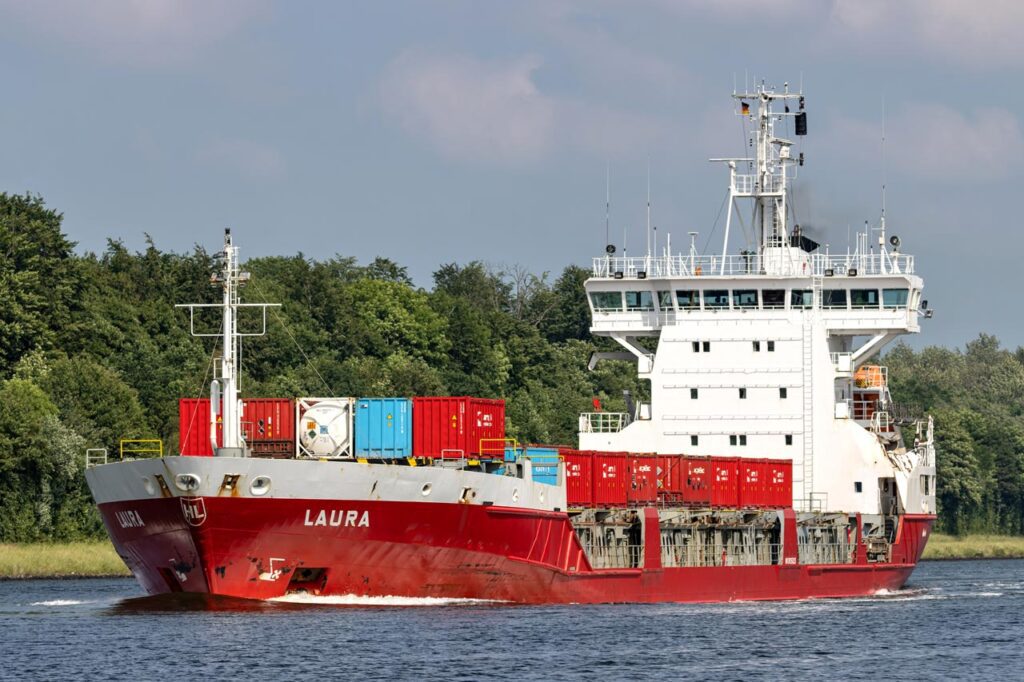MV Laura – a non-cellular ‘General Cargo’ vessel (GT 5329) with containers loaded on to the hatch covers.
Introduction
The port congestion delays caused by COVID 19 have driven the charter rates for specialist cellular container ships and multi-purpose non-cellular vessels designed and fitted to carry containers to all-time highs. In turn, this has generated a market demand for non-specialist tonnage that can also be used to carry containers, including bulk carriers and general cargo vessels. This Risk Bulletin discusses the associated problems and risks which can be experienced by non-specialist vessel owner Members and the essential precautions required to counter those risks.
Background
Cellular and multi-purpose non-cellular container ships are designed, built and equipped to flag state/ RO class approval to load, stow, secure, carry and discharge containers safely. Their specialist features will normally include container cell guides, cargo hold tank tops and double wide hatches with high loading weight capacities, container twistlock and lashing systems which meet or exceed SOLAS Cargo Securing Manual (CSM) requirements and Load Line Convention (LLC) compliant Stability Booklets which are specifically approved for container carriage.
Despite all of the above noted special care precautions, it is well known that significant container and cargo damage losses due to container stack collapses occur each year on board specialist container vessels. So, what might occur in similar circumstances when containers are loaded and carried on board non-specialist vessels? More importantly, what needs to be done to ensure non-specialist vessel, crew and container cargo safety and avoid such losses?
Non-Specialist Vessel Container Pre-Loading Risk Assessment
As an integral part of ship safety and ISM Code compliance, it is always essential that all cargoes are formally risk assessed to ensure their safe carriage on board any vessel. This is of particular importance when planning to load containers on board a non-specialist vessel i.e. one which has not been originally designed, built and equipped with flag state/class RO approval to do so.
MM recommends that a formal assessment of the safety compliance factors listed below should be undertaken by non-specialist vessel owner Members and their ship managers well before containers are booked for loading. Further, that positive action is taken to rectify any deficiencies or shortcomings well before loading.
- LLC Stability Booklet: Check to ensure it contains safe stability example calculations which include the carriage of a both full and partial loads of containers both on and below the main deck.
If deficient: Member should contact their vessel’s flag state/class RO to discuss and, as appropriate, obtain supplementary container cargo stability calculation examples for formal approval and inclusion into the vessel’s Stability Booklet.
NOTE 1. Masters and deck officers who have not served on board specialist container vessels may not be aware of the dangers to a container deck cargo of an excessive metacentric height (GM) stability which can cause a vessel to roll both quickly and heavily. Heavy rolling to large angles may generate forces that exceed the maximum safe working load (SWL) of lashing plan limits. The breakage of container securing, sudden stack collapse and containers lost overboard may then occur.
NOTE 2. Conversely, a GM which is inadequate can lead to the capsize of a container carrying vessel. Members should therefore ensure that they provide their ship managers and masters with access to MM Risk Bulletin No. 30, Stability Vigilance: Containerships and Cargo Ships Carrying Containers.
NOTE 3. Members should consider the contractual engagement of a professional weather forecasting and voyage planning organisation to assist the master with the avoidance of any weather systems which could endanger the safe stability of the ship and container cargo. Examples include the dangerous consequences of heavy seas and swells and resultant synchronous or parabolic rolling. - SOLAS CSM: Check to ensure the CSM (as amended to conform with MSC.1/Circ.1353/Rev.2) contains the details of the container securing fittings (e.g. stacking cones, twist locks and lashings) required by the IMO’s Code of Safe Practice for Cargo Stowage and Securing (CSS), 2021 Ed., Annex I, Safe stowage and securing of containers on deck of ships which are not specially designed and fitted for the purpose of carrying containers.
If deficient: Member should contact their vessel’s flag state/class RO to discuss and, as appropriate, obtain supplementary container stowage and securing data and guidance for formal approval and inclusion into the vessel’s CSM.
NOTE 1. If container securing fittings require to be welded into place, Members should confer with their flag state/class RO to ensure their construction and welding attachment are to regulatory standards. Hot work safety and permit obligations must of course also be complied with.
NOTE 2. All container securing fittings and lashing equipment, inclusive of chains and tightening gear, must be to flag state/class RO requirements with the Safe Working Load (SWL) clearly marked and recorded.
NOTE 3: It is essential that container securing be inspected by the crew during a voyage on a regular and vessel ISM Code/SMS safe work and hold entry basis. All inspections, lashing condition and any tightening required should be recorded in the Deck Log. - SOLAS Document of Dangerous Goods Compliance (DOC): As containers frequently contain dangerous goods, as defined by the International Maritime Dangerous Goods (IMDG) Code, then a SOLAS Ch. II-2 Reg. 19 DOC may well be required. If so, the DOC may also require that the carrying vessel be fitted with a fixed fire fighting system in the cargo holds. Many bulk carriers are not fitted with this equipment as the cargoes they can carry legally are restricted.
If deficient: First, confer with the intended container shipper/charterer to ascertain if shipped containers will contain dangerous cargo. If ‘yes’, then contact flag state/class RO to obtain regulatory guidance along with the issue of an approved DOC. If a fixed firefighting system in the cargo holds is required to carry dangerous cargo below deck but is is not fitted, then a supplementary firefighting system may be required to meet regulatory requirements. - SOLAS Bridge Visibility and COLREGS Navigation Lights: Check with flag state/class RO to ensure compliance while loaded with containers on deck with Navigation Bridge Visibility (SOLAS Ch. V Reg. 22) minimum requirements and visibility of Vertical and Horizontal Sectors of Navigational Lights (COLREG 72, Annex I/9 and Annex I/10).
If deficient: Adjust container deck stowage plan to meet bridge visibility and/or navigation light sector visibility requirements, or adjust the position of the navigation lights, and obtain flag state/class RO formal approval.
Conclusion and Takeaway
Members operating bulk carriers or general cargo vessels not originally designed and approved to carry containers may wish to take advantage of the current high freight and hire rates for the carriage of loaded and/or re-positioning of empty containers. However, before finalising any agreements to do so, Members should conduct a formal risk assessment based on the MM recommendations made in this Risk Bulletin. They should then carefully consider the time required and the costs involved in ensuring that their vessels meet full regulatory compliance.
If Members then decide to proceed with the processes required and obtain formal flag state/class RO approvals to carry containers, they may also wish to engage the services of a marine surveyor or consultant with an in-depth knowledge of containers and their safe carriage by sea. MM would consider it prudent for a Member with a limited experience of safe container carriage to do so.
Finally, Members should also confer with their P&I brokers and MM to ensure that their intention to carry containers is known to MM well in advance of shipment and that the terms of their P&I cover are adequate to cover the liabilities which may be incurred.


